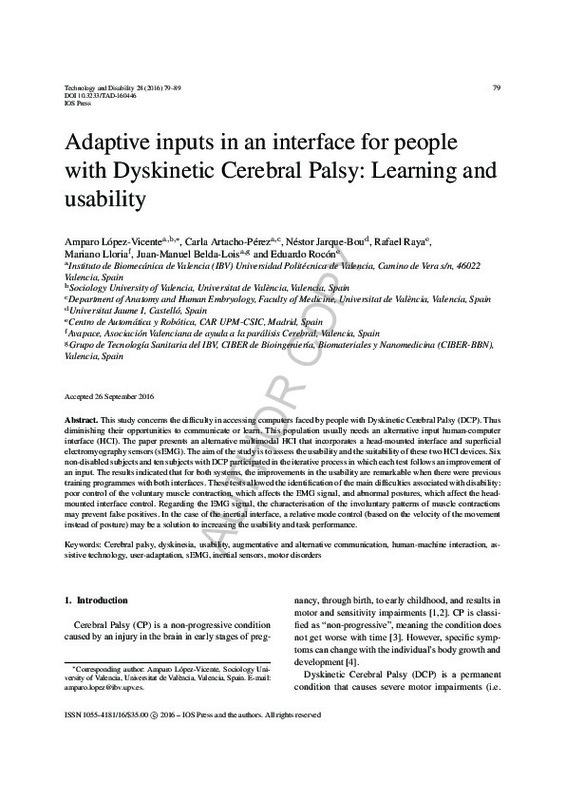JavaScript is disabled for your browser. Some features of this site may not work without it.
Buscar en RiuNet
Listar
Mi cuenta
Estadísticas
Ayuda RiuNet
Admin. UPV
Adaptive inputs in an interface for people with Dyskinetic Cerebral Palsy: Learning and usability
Mostrar el registro sencillo del ítem
Ficheros en el ítem
| dc.contributor.author | López Vicente, Mª Amparo
|
es_ES |
| dc.contributor.author | Artacho Perez, Carla Andrea
|
es_ES |
| dc.contributor.author | Jarque Bou, Nestor Jose
|
es_ES |
| dc.contributor.author | Raya, Rafael
|
es_ES |
| dc.contributor.author | Lloria, Mariano
|
es_ES |
| dc.contributor.author | Belda Lois, Juan Manuel
|
es_ES |
| dc.contributor.author | Rocon, Eduardo
|
es_ES |
| dc.date.accessioned | 2017-06-26T10:47:07Z | |
| dc.date.available | 2017-06-26T10:47:07Z | |
| dc.date.issued | 2016-12-05 | |
| dc.identifier.issn | 1055-4181 | |
| dc.identifier.uri | http://hdl.handle.net/10251/83625 | |
| dc.description.abstract | This study concerns the difficulty in accessing computers faced by people with Dyskinetic Cerebral Palsy (DCP). Thus diminishing their opportunities to communicate or learn. This population usually needs an alternative input human-computer interface (HCI). The paper presents an alternative multimodal HCI that incorporates a head-mounted interface and superficial electromyography sensors (sEMG). The aim of the study is to assess the usability and the suitability of these two HCI devices. Six non-disabled subjects and ten subjects with DCP participated in the iterative process in which each test follows an improvement of an input. The results indicated that for both systems, the improvements in the usability are remarkable when there were previous training programmes with both interfaces. These tests allowed the identification of the main difficulties associated with disability: poor control of the voluntary muscle contraction, which affects the EMG signal, and abnormal postures, which affect the head-mounted interface control. Regarding the EMG signal, the characterisation of the involuntary patterns of muscle contractions may prevent false positives. In the case of the inertial interface, a relative mode control (based on the velocity of the movement instead of posture) may be a solution to increasing the usability and task performance. | es_ES |
| dc.language | Inglés | es_ES |
| dc.publisher | IOS Press | es_ES |
| dc.relation.ispartof | Technology and Disability | es_ES |
| dc.rights | Reconocimiento - No comercial (by-nc) | es_ES |
| dc.subject | Cerebral palsy | es_ES |
| dc.subject | dyskinesia, usability | es_ES |
| dc.subject | augmentative and alternative communication | es_ES |
| dc.subject | human-machine interaction | es_ES |
| dc.subject | assistive technology | es_ES |
| dc.subject | user-adaptation | es_ES |
| dc.subject | sEMG | es_ES |
| dc.subject | inertial sensors | es_ES |
| dc.subject | motor disorders | es_ES |
| dc.subject.classification | INGENIERIA MECANICA | es_ES |
| dc.title | Adaptive inputs in an interface for people with Dyskinetic Cerebral Palsy: Learning and usability | es_ES |
| dc.type | Artículo | es_ES |
| dc.identifier.doi | 10.3233/TAD-160446 | |
| dc.rights.accessRights | Abierto | es_ES |
| dc.contributor.affiliation | Universitat Politècnica de València. Escuela Técnica Superior de Ingenieros Industriales - Escola Tècnica Superior d'Enginyers Industrials | es_ES |
| dc.contributor.affiliation | Universitat Politècnica de València. Instituto Universitario Mixto de Biomecánica de Valencia - Institut Universitari Mixt de Biomecànica de València | es_ES |
| dc.description.bibliographicCitation | López Vicente, MA.; Artacho Perez, CA.; Jarque Bou, NJ.; Raya, R.; Lloria, M.; Belda Lois, JM.; Rocon, E. (2016). Adaptive inputs in an interface for people with Dyskinetic Cerebral Palsy: Learning and usability. Technology and Disability. 28(3):79-89. doi:10.3233/TAD-160446 | es_ES |
| dc.description.accrualMethod | S | es_ES |
| dc.relation.publisherversion | http://doi.org/10.3233/TAD-160446 | es_ES |
| dc.description.upvformatpinicio | 79 | es_ES |
| dc.description.upvformatpfin | 89 | es_ES |
| dc.type.version | info:eu-repo/semantics/publishedVersion | es_ES |
| dc.description.volume | 28 | es_ES |
| dc.description.issue | 3 | es_ES |
| dc.relation.senia | 333086 | es_ES |







![[Cerrado]](/themes/UPV/images/candado.png)

